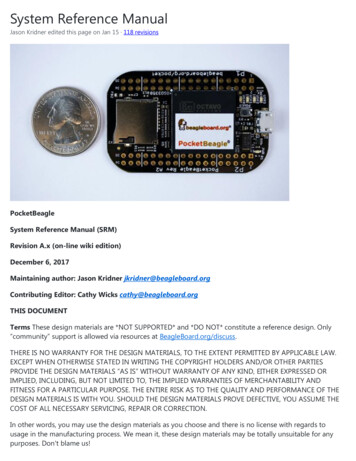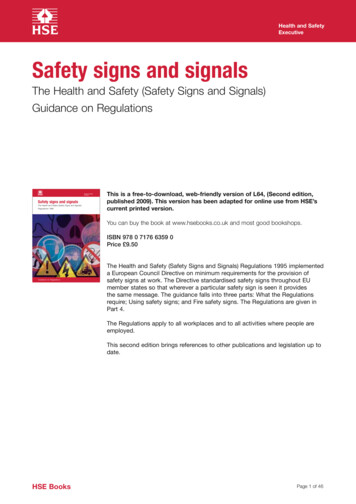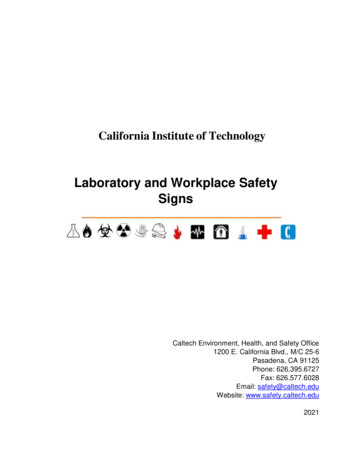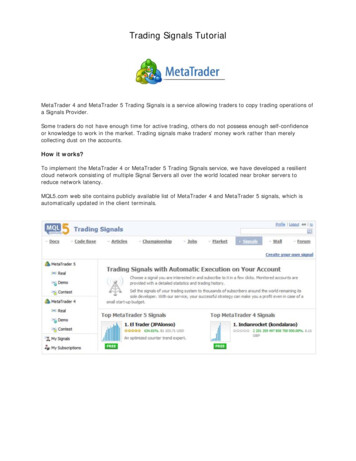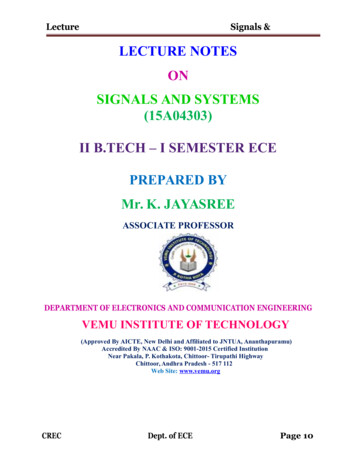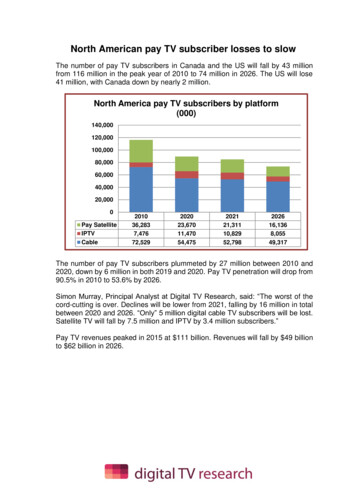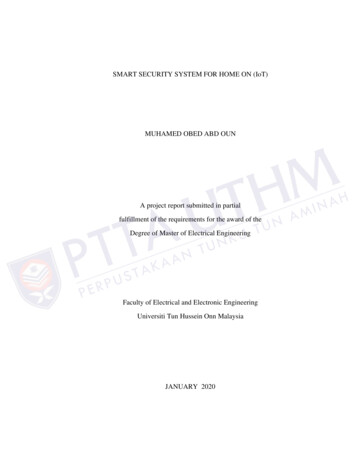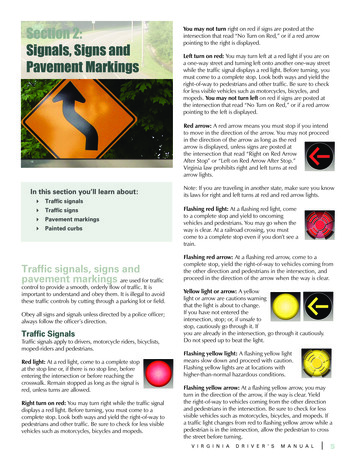
Transcription
Section 2:Signals, Signs andPavement MarkingsYou may not turn right on red if signs are posted at theintersection that read “No Turn on Red,” or if a red arrowpointing to the right is displayed.Left turn on red: You may turn left at a red light if you are ona one-way street and turning left onto another one-way streetwhile the traffic signal displays a red light. Before turning, youmust come to a complete stop. Look both ways and yield theright-of-way to pedestrians and other traffic. Be sure to checkfor less visible vehicles such as motorcycles, bicycles, andmopeds. You may not turn left on red if signs are posted atthe intersection that read “No Turn on Red,” or if a red arrowpointing to the left is displayed.Red arrow: A red arrow means you must stop if you intendto move in the direction of the arrow. You may not proceedin the direction of the arrow as long as the redarrow is displayed, unless signs are posted atthe intersection that read “Right on Red ArrowAfter Stop” or “Left on Red Arrow After Stop.”Virginia law prohibits right and left turns at redarrow lights.In this section you’ll learn about: Traffic signals Traffic signs Pavement markings Painted curbsTraffic signals, signs andpavement markings are used for trafficcontrol to provide a smooth, orderly flow of traffic. It isimportant to understand and obey them. It is illegal to avoidthese traffic controls by cutting through a parking lot or field.Obey all signs and signals unless directed by a police officer;always follow the officer’s direction.Traffic SignalsTraffic signals apply to drivers, motorcycle riders, bicyclists,moped-riders and pedestrians.Red light: At a red light, come to a complete stopat the stop line or, if there is no stop line, beforeentering the intersection or before reaching thecrosswalk. Remain stopped as long as the signal isred, unless turns are allowed.Right turn on red: You may turn right while the traffic signaldisplays a red light. Before turning, you must come to acomplete stop. Look both ways and yield the right-of-way topedestrians and other traffic. Be sure to check for less visiblevehicles such as motorcycles, bicycles and mopeds.Note: If you are traveling in another state, make sure you knowits laws for right and left turns at red and red arrow lights.Flashing red light: At a flashing red light, cometo a complete stop and yield to oncomingvehicles and pedestrians. You may go when theway is clear. At a railroad crossing, you mustcome to a complete stop even if you don’t see atrain.Flashing red arrow: At a flashing red arrow, come to acomplete stop, yield the right-of-way to vehicles coming fromthe other direction and pedestrians in the intersection, andproceed in the direction of the arrow when the way is clear.Yellow light or arrow: A yellowlight or arrow are cautions warningthat the light is about to change.If you have not entered theintersection, stop; or, if unsafe tostop, cautiously go through it. Ifyou are already in the intersection, go through it cautiously.Do not speed up to beat the light.Flashing yellow light: A flashing yellow lightmeans slow down and proceed with caution.Flashing yellow lights are at locations withhigher-than-normal hazardous conditions.Flashing yellow arrow: At a flashing yellow arrow, you mayturn in the direction of the arrow, if the way is clear. Yieldthe right-of-way to vehicles coming from the other directionand pedestrians in the intersection. Be sure to check for lessvisible vehicles such as motorcycles, bicycles, and mopeds. Ifa traffic light changes from red to flashing yellow arrow while apedestrian is in the intersection, allow the pedestrian to crossthe street before turning.V I R G I N I AD R I V E R ’ SM A N U A L 5
Section 2: Signals, Signs and Pavement MarkingsGreen light or arrow: At a green light, you may go if the wayis clear. At a green arrow, you may go in the direction of thearrow if the way is clear. If youare turning without a green arrow,you must yield the right-of-wayto vehicles coming from the otherdirection and pedestrians in theintersection. Be sure to check forless visible vehicles such as motorcycles, bicycles, and mopeds.If a traffic light changes from red to green while a pedestrianis in the street, allow the pedestrian to cross the street beforeturning.Traffic SignsOut of service signals: When traffic signals are not workingbecause of a power outage or other problem and not displayingany lights, you are required to stop, proceeding through theintersection as though it were an all-way stop. This does notapply if a law enforcement officer or other authorized person isdirecting traffic at the intersection, or if portable stop signs are inuse.Red used with white conveys stop, yield, do not, and no. Stopsigns, yield signs, do not enter or wrong way signs, the circleand slash in a no turn sign, and the restrictions in a parking signare examples.Lane use signals indicate lanes where you can andcannot drive during different hours of the day.Red X: Never drive in a lane marked witha red X signal.Green Arrow: You are permitted to drive in alane marked with a green arrow signal.Left-turn Arrow: You are permitted to enter in alane marked with a one-way ortwo-way arrow only to turn in thedirection of the arrow.Pedestrian Hybrid Beacons(PHBs): PHBs appear over intersections without stoplights andalert drivers when pedestrians are ata crosswalk. One yellow light at thebottom flashes when a pedestrianactivates the PHB. Next, the yellowlight turns solid to alert drivers toprepare to stop. Then, the top twored lights on the PHB turn solidwhile a walk signal appears at thecrosswalk, and drivers must stop.Lastly, while the walk signal countsdown for the pedestrians, the PHB’s two red lights alternateflashing, telling the driver that if the crosswalk is now clear, theymay proceed with caution.V I R G I N I AD R I V E R ’ Simportant information about the sign’s message. In poorvisibility conditions, such as heavy fog, you may be able tomake out only the shape of a sign. As you approach a sign andwhile still distant, you may see the color long before you canread the message or see the symbol, giving you some advanceinformation.Sign ColorsSign colors help you know what the intention of the sign is.Black used with white conveys regulatory information. Speedlimit, do not pass, no turns are examples where the operation isregulated by law and the black and white sign would be found.Yellow used with black conveys a warning. Curve ahead,stop ahead, overhead clearances, slippery when wet, are allexamples. A specialized class of warning signs uses a strongyellow/green color with black to advise of school zone,pedestrian and/or bicyclist activities.Green and white, blue and white, and brown and white signsare used to provide helpful information. The green sign is usedto provide destination types of information, while the blue signis used to inform regarding motorists services. The brown sign isused to advise of historical or cultural interests that might existin the area.Yellow X or Yellow DiagonalDownward Arrow: These signalsmean that you should move outof the lane as soon as safelypossible.6 The color and shape of a traffic sign communicatesM A N U A LOrange and black and pink and black signs are used toadvise and warn in construction (orange) and incident (pink)areas. They are used with black and white signs that conveyregulations that might exist only because of the constructioneffort or the incident.Sign ShapesOctagon (Stop): This eight-sidedshape always means stop. Youmust come to a complete stopat the sign, stop line, pedestriancrosswalk or curb. Wait for anyvehicle or pedestrian to clear the way. At some intersectionsyou’ll find a sign beneath the stop sign that reads “All Way” or“4 Way.” At these intersections all vehicles on all roads leadinginto the intersection must stop. If you get to the intersectionat the same time as other vehicles, the driver on the left mustyield to the driver on the right.Triangle (Yield): You mustslow down as you come to theintersection. Be prepared to stop.Let any vehicles, pedestrians orbicyclists safely pass before youproceed.
Section 2: Signals, Signs and Pavement MarkingsRectangle (Regulatory or Guide):Vertical signs generally giveinstructions or tell you the law.Horizontal signs may give directionsor information.No U-Turn: U-turns are illegal. Do not makea U-turn when you see this sign.Diamond (Warning): These signs warnyou of special conditions or hazards ahead.Slow down and drive with caution. Be readyto stop.No Turn on Red: You may not turn on thered light. Wait for the signal to turn green.Pentagon (School Zone/School Crossing):This five-sided shape marksschool zones and warns youabout school crossings. Twosigns may be used together toshow the actual location of thecrosswalk.Regulatory signs inform you of the law;you must obey their instructions. Rememberthat a red circle with a slash means NO —the symbol inside the circle tells you what isprohibited.Speed Limit: These signs tell you the maximum legal speedthat you may drive on the road where the sign is posted whenweather conditions are good. Some roadshave electronic speed limit signs that changebased on weather or traffic conditions. Duringrain, snow and ice, you may receive a ticketfor driving too fast for the conditions evenif you are driving at or less than the postedspeed limit.Do Not Enter – Wrong Way: These signs mean you cannotdrive in that direction. If you drive past thesesigns you are going in thewrong direction and couldget into a head-on crash withvehicles headed your way.Cautiously turn around.One Way: Traffic flows onlyin the direction of the arrow.No Left Turn: Left turns are against the law.In Virginia, U-turns are considered as two leftturns and are illegal if this sign is posted.Do Not Pass: This sign marks the beginningof a no passing zone. You may not pass carsahead of you in your lane, even if the way isclear.Left Turn Yield on Green: This sign is usedwith a traffic signal. It tells you that the trafficturning left at a green light does not have theright-of-way and must yield to traffic comingfrom the other direction. Stop and look foroncoming traffic, then proceed with caution.Keep Right: A traffic island, median or barrier isahead. Keep to the side indicated by the arrow.Lane Use Control: Thesesigns are used where turns arerequired or where special turningmovements are permitted forspecific lanes. Traffic in the lanemust turn in the direction ofthe arrow.High Occupancy Vehicle: These signsindicate lanes reserved for buses andvehicles with a driver and one or morepassengers as specified on the sign.Disabled Parking: Parking spaces markedwith these signs are reserved for people withdisabled parking permits.No Right Turn: Right turns are illegal. Do notmake a right turn when you see this sign.V I R G I N I AD R I V E R ’ SM A N U A L 7
Section 2: Signals, Signs and Pavement MarkingsWarning signs alert you to possible hazards ahead. Slowdown and watch for other pavement markings, signs, signalsor work zones that may follow.Advisory Speed: This sign indicates themaximum safe speed for a highway exit.Slippery When Wet: When pavement iswet, reduce your speed. Do not brake hardor change direction suddenly. Increase thedistance between your car and the one aheadof you.Low Clearance Sign: The overpass ahead hasa low clearance. Do not proceed if your vehicleis taller than the height shown on the sign.Hill: A steep grade is ahead. Check yourbrakes.Reduced Speed Limit Ahead: Prepareto reduce your speed; the speed limit ischanging ahead.Deer Crossing: Deer cross the roadway inthis area. Slow down, be alert and be readyto stop.Stop Ahead/Yield Ahead: A stopsign or yield sign is ahead. Slowdown and be ready to stop.Horse-Drawn Buggies: Regularly travel in thisarea. Slow down and don’t use the horn. Statelaw requires motorists to pass with at least threefeet of clearance when the way is clear.Signal Ahead: Traffic signals areahead. Slow down and be ready to stop.No Passing Zone: This sign marks thebeginning of a no passing zone. You may notpass cars ahead of you in your lane, even ifthe way is clear.Merge: Two lanes of traffic moving in the samedirection are about to become one. Drivers inboth lanes are responsible for merging safely.Lane Reduction: The right lane ends soon.Drivers in the right lane must merge left whenspace opens up. Drivers in the left lane shouldallow other vehicles to merge smoothly.Divided Highway Begins: The highway aheadis split into two separate roadways bya median or divider and each roadway isone-way. Keep right.Divided Highway Ends: The highway aheadno longer has a median or divider. Traffic goesin both directions. Keep right.Tractors and Farm Equipment: Regularlytravel in this area. Be ready to slow down orstop. Only pass when the way is clear.Pedestrian Crossing: Watch forpeople entering a crosswalk orcrossing your path. Slow downand be prepared to stop. Asecond sign with an arrow mayshow the actual location of thecrosswalk.Bicycle Crossing/Bike Path:Bicycles regularly cross or ridebeside traffic in this area. Drivewith caution. A second sign withan arrow may show the actuallocation of the bike crossing.School Zone/School Crossing:Watch out for children crossingthe street or playing. Be readyto slow down or stop. Obeyspeed limits and signals from anycrossing guards. A second sign withan arrow may show the actuallocation of the sidewalk.Open Joints: Slow down. Open joints onbridges or ramps could cause a motorcyclistto lose control of the motorcycle.8 V I R G I N I AD R I V E R ’ SM A N U A L
Section 2: Signals, Signs and Pavement MarkingsExpansion Joints: This sign is used when ajoint across lanes creates a bump or is wideenough to cause loss of traction inwet weather.Intersections: An intersectionis ahead. Be alert for vehiclesentering the road on which youare traveling.Y Intersection: You must beareither right or left ahead.T Intersection: The roadway you are travelingon ends ahead at a stop sign. You must turnright or left after yielding to oncoming trafficand pedestrians.Roundabout: These signs indicate a circularintersection with an island in the centeris ahead. Also called traffic circles, theseintersections may have one or more lanes.Entering traffic must yield the right-of-wayto traffic already in the circle and travel in acounter clockwise direction.Right Curve – Side Road: The road aheadcurves right and a side road joins from theleft within the curve. Be alert for vehiclesentering the roadway you are traveling on.Sharp Right Turn: Slow down and beprepared for a sharp right turn in theroad ahead.Sharp Right and Left Turns: Slow downand be prepared for the road ahead toturn sharply right, then left.Right and Left Curves: The road aheadcurves right, then left. Slow down.Right Curve with Safe Speed Indicator:The road ahead curves right. Slow downto the safe speed indicated.Winding Road: The road ahead winds witha series of turns or curves. On all curves, slowdown for better control.Low Ground Railroad Crossing: A steepslope where the railroad tracks cross the roadmay cause the bottom of low vehicles to getcaught or drag on the tracks.Railroad Crossing: Advance warning signsare placed before a railroad crossing. Thesesigns warn you to look, listen, slow down andbe prepared to stop for trains or any vehiclesusing the rails.Railroad Crossbuck: This sign is a warning of arailroad crossing. Look, listen, slow down andbe prepared to stop for trains or any vehiclesusing the rails. Trains may be approachingfrom either direction. If there is more than onetrack, trains may be approaching from eitherdirection on either track.Railroad Crossbuck and Flashing Lights:Flashing lights may be used with crossbucksigns. Always stop when the light begins toflash and be alert for approaching trains.Do not proceed until all trains or any othervehicles using the rails have passed, the tracksare clear, and the lights are no longer flashing.Be especially alert at multi-track crossingsbecause a second train could be approachingfrom the opposite direction.Crossbuck, Flashing Lights and Gate: Gatesare used with flashing light signals at somecrossings. Stop when the lights begin to flash andbefore the gate lowers. Remain stopped until thegates are raised and the lights stopflashing. Do not attempt to drivearound the lowered gate.Pavement markings,consisting of an X andRR, may be paintedon the pavementat the approach tosome crossings. Whenapproaching railroadtracks, be alert. Trainsmay approach thecrossing at any time andfrom either direction.Unless you can clearthe tracks completely, never start across the tracks. Make surethere is room for your vehicle on the other side of the tracksbefore proceeding.V I R G I N I AD R I V E R ’ SM A N U A L 9
Section 2: Signals, Signs and Pavement MarkingsNote: School buses must always stop at railroad crossings,even when the lights are not flashing.If a dangerous condition exists at a rail crossing, call thenumber listed on the emergency sign.This will allow the rail company tostop or reroute approaching rail trafficuntil the hazard is removed. Be sureto give the posted crossing numberso that the hazard can be identifiedcorrectly.If your carstalls on thetracks, don’thesitate. Getout of the carright away andrun diagonallyaway from thetracks in thedirection ofthe oncomingtrain.Rough Road, Bump, or Uneven Lanes: These signs areused when certain road conditions, such as loose gravel orroad construction,affect the roadwaysurface and createpotentially difficultconditions formotorists, especiallymotorcyclists.Road Construction Ahead – Detour: Thesesigns indicate a change in the traffic patternor route ahead. Slow down. Unusual orpotentially dangerous conditions are ahead.D R I V E R ’ SMessage Boards: You may see portable or permanent messageboards along roadways. They provide information about traffic,road, weather or other hazardous conditions. Always obey anydirections posted on these message boards. For informationabout road conditions or road construction in advance of yourtrip, visit www.virginiadot.org, www.511virginia.org or call 511.Rumble Strips Ahead signs warn motorists ofblack or orange strips placed across the travellanes in advance of work zones, including aflagger or lane closure. Rumble strips shouldbe slowly driven over, not swerved around.Slow Moving Vehicles traveling at 25 MPH or less,such as farm equipment, horse-drawn vehiclesor highway work vehicles, must display thesesigns when using a public highway. Be preparedto adjust your speed or position when you seea vehicle with one of these signs.Pavement MarkingsRoad markings guide and warn drivers as well as regulatetraffic. Markings may be red, yellow or white. They may beused alone or in combinations. Each has a different meaning.Flashing Arrow Boards: Large flashing arrowboards or flashing message signs in work zonesdirect drivers to proceed into different trafficlanes and inform them that part of the roadahead is closed.V I R G I N I APhoto Speed Enforcement: This signindicates that automated photo enforcementis in place for speeding in a work zone.Always obey the posted speed limit in awork zone.Traffic Control Devices:Barricades, vertical signs, concretebarriers, drums and cones are the mostcommon devices used to guide driverssafely through work zones. When drivingnear the devices, keep your vehicle in themiddle of the lane and obey the postedspeed limit. As you leave the work zone,stay in your lane and maintain your speed.Don’t change lanes until you are completelyclear of the work zone.In a work zone, the lives of highway workers depend ondrivers like you obeying the posted speed limits and avoidingdistractions. If you are convicted of exceeding the speed limitin a highway work zone, you may be fined up to 500. If youare convicted of using a handheld communications device ina highway work zone, you will be fined 250. Remember, thecolor orange marks a work zone and means slow down and bealert.10 Flaggers: Flaggers are highway workerswho normally wear orange or yellowvests, or yellow-green shirts or jackets.They use STOP/SLOW paddles or redflags to stop or direct traffic through thework zone, and to let other workers orconstruction vehicles cross the road.M A N U A LRed markings are generally not used; but, some communitiesdo use red curbs to indicate no parking zones.Red reflectors on the pavement show areas not to be enteredor used. They are positioned on the road surface so that onlytraffic flowing in the wrong direction would observe them.
Section 2: Signals, Signs and Pavement MarkingsYellow center lines mean two-way traffic, flowing inopposite directions.Broken yellow centerlines mean that passingon the left is allowed ineither direction whenthe way ahead is clear.A broken yellow linealongside a solid yellowline means that passing isallowed from the side ofthe broken line, but notfrom the side of the solidline.Vehicles on the solid yellowline side may only cross theline to pass pedestrians,bicyclists, and riders of scooters or skateboards, when theopposite lane is clear and you can pass safely.Double solid yellow linesmark the center of the roadand separate traffic travelingin two different directions.Passing is not allowed ineither direction. You maynot cross the lines unlessyou are making a left turnor passing pedestrians,bicyclists, and riders ofscooters or skateboards,when the opposite lane isclear and you can pass safely.Broken white linesseparate lanes of trafficgoing in the same direction.You may change lanes withcaution.Dotted white lines are actually small rectangles in a serieswhere each is closely spaced to the next. They are used toshow lane assignment in intersections and interchanges wherethere might otherwise be a tendency to drift out of a lane oran area of intended use. Often they are used to guide twoturning lanes through the intersection. Dotted white linesare also used to denote the opening of a turn lane at anintersection and entrance/exit lanes at interchanges.Many two-lane roads in Virginia do not have lane markingsto separate the lanes. On an unmarked two-lane road, youmay pass a slow moving vehicle on the left side if there are nosigns prohibiting passing. Make sure that the way is clear.Solid white lines show turn lanes and discourage lanechanges near intersections, interchange/on- and off-ramps,and at other locations where lane changes might bedangerous.Solid whitelines also markthe right edgeof pavement.Arrows usedwith white linesindicate whichturn may bemade from thelane. Stop lines,crosswalks andparking spacesalso are markedby white lines.White lane arrows are curved or straight. If you are in alane marked with a curved arrow or a curved arrow and theword ONLY, you must turn in the direction of the arrow. Ifyour lane is marked with both a curved and straight arrow,you may turn or go straight.Double solid white lines separate lanes of traffic going inthe same direction. Mostoften they are used todesignate special use lanefrom conventional lanes,as when used to separatea High Occupancy Vehiclelanes from the other lanes ofan expressway. You may notcross these lines. You mayenter the designated specialuse lane only where signsand markings allow.V I R G I N I AD R I V E R ’ SM A N U A L 11
Section 2: Signals, Signs and Pavement MarkingsYield line is a line oftriangles extending acrossthe roadway that may beused with a yield sign toshow the point at whichyou must yield or stop, ifnecessary. A yield line isoften seen at the entranceof a roundabout.On three-lane roads with traffic moving in both directions,road markings show when drivers may use the center lane formaking left turns or for passing.If the center lane is marked by a single broken yellow lineon both sides, drivers traveling in either direction may usethe center lane for passing.If both sides of the centerlane are marked by a solidyellow line and a brokenyellow line, drivers travelingin either direction may usethe lane for making left turns.However, they may not travelfurther than 150 feet in thislane.A shared lane marking, orsharrow, consists of a bicyclesymbol with a doublechevron arrow above it andis used on travel lanes toonarrow for motor vehiclesand bicycles to share side-byside. Sharrows clarify wherebicyclists are encouraged toride in the lane and reminddrivers to expect bicyclistson the road.V I R G I N I AD R I V E R ’ SHigh Occupancy Vehicles (HOV)lanes are marked on highways by adiamond shape in the center of thelane. HOV lanes may also be speciallanes separated by a barrier or soliddouble white lines. Duringheavy traffic periods, HOVlanes are reserved forbuses, vanpools, carpools,other high occupancyvehicles, motorcycles, andcertain clean special fuelvehicles. Road signs showthe minimum number ofpassengers a vehicle mustcarry (excluding motorcyclesand clean fuel vehicles) touse the HOV lanes and the times that HOV restrictions are ineffect. If the lanes are separated by a barrier, they are reversible.This means that during certain times of the day, traffic flows oneway. During other times of the day, traffic flows in the oppositedirection. A diamond-shaped marking may also indicate thatthe lane is reserved for use as a bus lane.Toll Plazas and LanesAll toll facilitiesin Virginia acceptpayment usingE-ZPass tolltransponders.Transpondersallow drivers topay electronicallywithout havingto stop to paywith cash. If youhave a transponder, as you approach a toll plaza look for andfollow signs with the purple E-ZPass logo. If you do not have atransponder, as you approach a toll plaza, look for and followsigns for cash only lanes.Bicycle lanes are indicated by a solid ordashed white line or green pavementmarkings, and a bicyclist symbol. A bicyclelane is for the preferential use of bicyclists.Drivers should not drive in the bicycle laneexcept when necessary to turn left or right.Before turning, check your mirrors forbicyclists that may be behind you andyield to bicycles in the lane.12 Bicycle boxesare paintedon the road atintersections.They contain awhite bicyclesymbol. Bikeboxes andthe bike lanesapproachingand leavingthe box may be painted green. Drivers must stop for a redtraffic signal behind all bicycle boxes, not inside the box.Bicycle riders will move into the box in front of drivers atthe intersection. Right turns on red are not allowed at theseintersections. If turning right on a green light, drivers mustsignal and yield to bicycles on the right.M A N U A L
Slow down as you approach toll plazas. Be extra cautious asyou approach, enter, and depart toll plazas. There may beother drivers changing lanes and/or toll employees crossingthe lanes.Some toll roads have high speed lanes reserved for vehicleswith E-ZPass transponders. Do not enter those lanes unlessyou have a transponder. However, if you do enter one of thoselanes by mistake, do not stop. Stopping is unsafe and couldcause a rear-end crash. Cameras will photograph the car’slicense plate number and the registered vehicle’s owner will bebilled for the toll.Section 3:Safe DrivingA painted curb means that you must follow special rules topark there. Check with the locality for specific meanings.Generally, the colors on the curb mean:White — Stop only long enough to pick up or dropoff passengers.Yellow — Stop only long enough to load or unload.Stay with your car.Red — Do not stop, stand or park.Every time you get behind the wheel, you acceptresponsibility for your actions. You must obey Virginia’s trafficlaws, and ensure the safety of you, your passengers, and othermotorists, pedestrians and bicyclists on the roadways.In this section you’ll learn about: Hand position Speed limits Stopping Yielding the right-of-way RoundaboutsHand PositionSit straight but relaxed and place your hands on the steeringwheel. If your steering wheel were a clock, your hands shouldbe at the 8 o’clock and 4 o’clock positions. Hold the wheelwith your fingers and thumbs. Avoid gripping it with yourpalms. Changing lanes Over-correcting Turning U-turns Turn signals Maintaining a space cushion Searching Blind spots Sharing the road Backing Parking Visibility Lights Hazardous conditions Dangerous driving behaviors Traffic crashes Deer hazards Traffic stopsV I R G I N I AD R I V E R ’ SM A N U A L 13
Sign colors help you know what the intention of the sign is. Red used with white conveys stop, yield, do not, and no. Stop signs, yield signs, do not enter or wrong way signs, the circle . Sign Shapes Octagon (Stop): This eight-sided shape always means stop. You must come to a complete stop at the sign, stop line, pedestrian crosswalk or curb .

